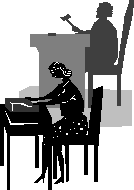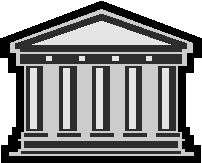Judges in the Classroom Lesson Plan |
|
The Courts – Elementary Level - What is a Court?
Source:
Margaret Fisher at the Washington State Administrative Office of the Courts (AOC) authored the lesson. For more information, contact AOC Court Services, 1206 Quince Street SE,
PO Box 41170, Olympia, Washington 98504-1170. For an electronic copy of this lesson, or to view other lesson plans, visit Educational Resources on the Washington Courts Web site at: www.courts.wa.gov/education/.
Objectives:
- Students will be able to describe the judicial branch of government.
- Students will be able to define what a court is.
- Students will be able to name three characteristics of a trial court and three characteristics of an appellate court.
Related Essential Learning Requirements:
While this lesson can positively address several of the Essential Academic Learning Requirements in Social Studies and Language Arts, the lesson plan identifies only those Learning Requirements most directly applicable.
As a result of this lesson, students will gain competence in the following Learning Requirements:
- Understand and explain the purpose and organization of the United States government: the executive, legislative, and judicial branches at, and among, the local, state, and federal levels of government. (Civics, EL 2, Bench 2.1)
- Understand the function and effect of law. (Civics, EL 2, Bench 2.2)
Grade Level:
Grades 3-6
Time:
One class period (approximately 50 minutes).
Materials:
Docu-Camera 1 (Trial Court and Appeals Court)—original provided
Handout 1 (Trial court or appeals court?)—original provided
Extension Activities:
The teacher may wish to conduct a mock trial with students to involve them in a court case. A scripted mock trial appropriate for elementary school students is available.
Procedures:
- Introduce the concept of court
by writing the word or drawing a picture on the board and asking students what they know about courts. Brainstorm and list on the board all the words that students come up with; for example, judge, jury, lawyers, crimes, cases, etc.
- Explain to students that there are two kinds of courts: trial courts and appeals courts.
Let students know they are going to learn a little more about appeals courts today and how they work in our state.
- Give students an example to which they might relate.
Let’s say your older sister is taking care of you and your brother. You and your brother disagree about who owns a particular soccer ball. You want to take the soccer ball to soccer practice, but your brother says it belongs to him and that he needs it. You both tell your sister your side of the story. Your brother brings in a neighbor who says the soccer ball definitely belongs to him. Your older sister decides that it belongs to your brother. You are unhappy with her decision and want a higher authority to review her decision, and hopefully agree with you that the ball belongs to you. Who would you ask? Probably your parent or guardian. This is what we mean by an appeal—that you ask a person with higher authority to review the decision that another person has made.
- Explain that in a very broad way
this is very much like what courts do. Trial courts are places where people bring conflicts or problems for a solution. The judge (and jury) listens to witnesses and evidence and makes a decision. If a person is unhappy with that decision, he or she can ask a court with authority over that court to review the decision. This is called an appeal.
We’re going to learn about some differences between a trial court and an appeals court; then we’ll do an exercise to see how to apply those differences. Put up Docu-Camera 1 on a docu-camera and go through the characteristics of trial court and appeals court with students. You might incorporate those words associated with courts from the initial brainstorm as they fit in either trial court or appeals court.
Pass out Handout 1 and ask students to separate into pairs or small groups to decide whether each situation is talking about a trial or an appeal. Have students give reasons for their answers.
Answers:
a) Lily testifies that the bank robber wore a mask. Trial court because only trial courts have witnesses who testify.
b) A group of judges listens to the lawyers argue. Appeals court because trial courts have a single judge and appellate courts have a panel of judges.
c) The jury decides that it was the stores fault that Khahn got hurt. Trial court because juries only operate in trial courts.
d) Terry asks the court to set aside his death sentence. Appeals court because Terry is asking to have the sentence imposed at the lower court set aside.
e) Ms. Nguyen, the attorney, argues to the judges that her client should win the case. Appeals court because there is more than one judge deciding the case.
f) Issues a written opinion that the school violated JoJo’s rights. Appeals court because only appellate judges issue written opinions.
g) The bailiff swears in the witness. Trial court because only trial courts have witnesses.
h) The gun used in the robbery is admitted as evidence. Trial court because only trial courts have evidence admitted.
i) Writes its decision that the judge made a mistake in the case. Appeals court because only appellate courts issue written decisions.
In Washington, the appeals court with the highest authority is the Washington Supreme Court. Whatever the Washington Supreme Court decides is the law; all the courts in Washington have to follow.
Conclude by brainstorming three characteristics of a trial court and three characteristics of an appeals court.
DOCU-CAMERA 1

Trial Court
- One judge conducts the trial.
- Jury or a single judge decides the case.
- Lawyers present evidence.
- Witnesses swear to tell the truth and answer questions from lawyers.
- Is the first court to decide who should win in a dispute.
- Is the first court to decide whether or not the defendant is guilty.

Appeals Court
- A panel of several judges listens and decides the case.
- Hears cases that have been decided in a lower court
- No evidence is presented.
- Lawyers only make arguments.
- Gives its decisions in a written opinion.
- Their decisions must be followed by all the trial courts that are under them.
HANDOUT 1
Name(s): _______________________________________________________________________________

Trial court or appeals court? Circle T for trial court and circle A for appeals court.
a) |
T |
A |
Lily testifies that the bank robber wore a mask. |
b) |
T |
A |
A group of judges listens to the lawyers argue. |
c) |
T |
A |
The jury decides that it was the stores fault that Khahn got hurt. |
d) |
T |
A |
Terry asks the court to set aside his death sentence. |
e) |
T |
A |
Ms. Nguyen, the attorney, argues to the judges that her client should win the case. |
f) |
T |
A |
Issues a written opinion that the school violated JoJo’s rights. |
g) |
T |
A |
The bailiff swears in the witness. |
h) |
T |
A |
The gun used in the robbery is admitted as evidence. |
i) |
T |
A |
Writes its decision that the judge made a mistake in the case. |
|







